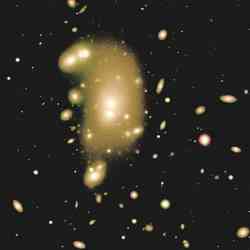
Galaxy cluster Abell 3266. Image credit: NOAO Click to enlarge
A comprehensive survey of more than 4,000 elliptical and lenticular galaxies in 93 nearby galaxy clusters has found a curious case of galactic ?downsizing.?
Contrary to expectations, the largest, brightest galaxies in the census consist almost exclusively of very old stars, with much of their stellar populations having formed as long ago as 13 billion years. There appears to be very little recent star formation in these galaxies, nor is there strong evidence for recent ingestion of smaller, younger galaxies.
By contrast, the smaller, fainter galaxies studied by the NOAO Fundamental Plane Survey are significantly younger?their stars were formed as little as four billion years ago, according to new results from the survey team to be published in the September 10, 2005, Astrophysical Journal.
These findings are based on a sample more than five times larger than previous efforts. The results of the survey contrast sharply with conventional hierarchical model of galaxy formation and evolution, where large elliptical galaxies in the nearby universe formed by swallowing smaller galaxies with young stars; this theory predicts that, on average, the stars in the largest elliptical galaxies should be no older than those in the smallest ones.
?This sample probes the largest and richest galaxy clusters in the nearby universe, out to a distance of about a billion light-years from Earth,? says Jenica Nelan, lead author of the study. ?Our analysis shows that there is a clear relationship between mass and age in these red galaxies, meaning that the stars in the biggest, oldest galaxies that we studied formed early in the history of the Universe. On average, the smaller galaxies have one-tenth the mass of the larger ones, and are only about half their age.?
?The term ?downsizing? essentially means that when the Universe was young, the star formation activity occurred in large galaxies, but as the Universe aged, the ?action? stopped in the larger galaxies, even as it continued in smaller galaxies,? says Michael Hudson of the University of Waterloo, Ontario, Canada, principal investigator for the NOAO Fundamental Plane Survey.
The new study is based on thousands of spectra obtained by the Fundamental Plane Survey team over dozens of nights at the WIYN 3.5-meter telescope at Kitt Peak National Observatory, southwest of Tucson, AZ, and the National Science Foundation?s Blanco 4-meter telescope at Cerro Tololo Inter-American Observatory, east of La Serena, Chile. With some painstaking work, these spectra can reveal the average age of the stars that make up a galaxy.
?Although we cannot directly see these galaxies as they were in the past, their stars are a kind of ?fossil record? that can be used to unearth their histories,? Hudson explains. ?It appears that the older galaxies are much less of a ?melting pot? than had been thought, and that their star formation activity turned off somehow while they were being put together.?
The evolutionary history of elliptical galaxies and lenticular galaxies (which have a central bulge and a disk, but no evidence of spiral arms) is not well understood. Their colors appear to be ?redder? than typical spiral galaxies. The largest ellipticals are the reddest of all, but until this work it has not been clear whether this property results primarily from being older in age, as the survey found, or from having a higher proportion of heavy chemical elements (metallicity content).
?These so-called red galaxies contain the bulk of the stellar mass in the nearby universe, but we know little about their formation and evolution,? says co-author Russell Smith of the University of Waterloo. ?It was thought that all of the red galaxies were made of stars that formed very early, and are now quite old. Our results show that while this is true for the large galaxies, the smaller ones formed their stars comparatively recently in the history of the Universe. We predict that as new surveys look deeper and hence further into the past, they should see fewer faint red galaxies?
An image of galaxy cluster Abell 3266 taken by survey team members at the Gemini South telescope as part of their follow-up work is available above.
Lead author Jenica Nelan completed this work while earning her doctorate at Dartmouth College; she is now an astronomer at Yale University.
Co-authors of this paper include Hudson and Smith of the University of Waterloo; Gary Wegner of Dartmouth College; John R. Lucey, Stephen A. W. Moore, and Stephen J. Quinney of the University of Durham, and Nicholas B. Suntzeff of NOAO?s Cerro Tololo Inter-American Observatory.
The Fundamental Plane Survey is one of 18 projects granted long-term access to observing nights at the telescope of the National Optical Astronomy Observatory (NOAO) under the NOAO Survey Program.
See here for more information:
www.noao.edu/gateway/surveys/programs.html and astro.uwaterloo.ca/~mjhudson/nfp
Original Source: NOAO News Release
